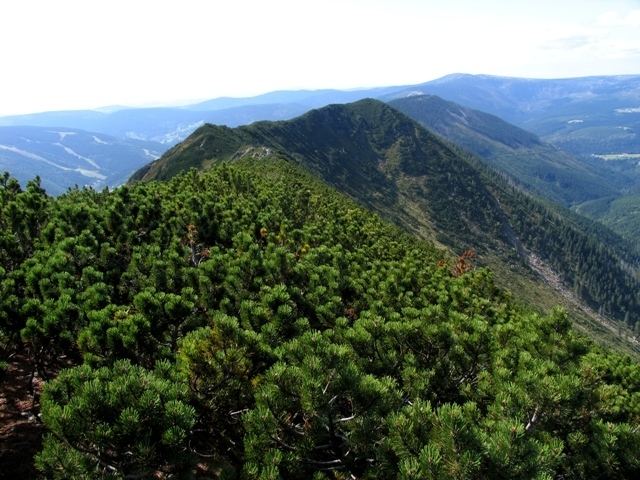Peak Sněžka Highest point Sněžka Passes Przełęcz Karkonoska | Elevation 1,603 m (5,259 ft) Country Czech Republic | |
 | ||
Countries Poland, Czech Republic and Germany States List
Lower Silesia
Bohemia
Moravia
Czech Silesia
Saxony Mountains Sněžka, Králický Sněžník, Wielka Sowa Similar Krkonoše, Sněžka, Owl Mountains, Stołowe Mountains, Králický Sněžník | ||
La verdad sobre el pacto de munich 1 4 checoslovaquia y los sudetes spanish
The Sudetes /suːˈdiːtiːz/ are a mountain range in Central Europe, also known in English (from their names in German and Czech/Polish) as the Sudeten or Sudety mountains.
Contents
- La verdad sobre el pacto de munich 1 4 checoslovaquia y los sudetes spanish
- Map of Sudetes 471 25 JablonnC3A9 v PodjeC5A1tC49BdC3AD Czechia
- EtymologyEdit
- SubdivisionsEdit
- HistoryEdit
- Sudetes and SudetenlandEdit
- TourismEdit
- Notable townsEdit
- References
Map of Sudetes, 471 25 Jablonn%C3%A9 v Podje%C5%A1t%C4%9Bd%C3%AD, Czechia
The range stretches from eastern Germany along the northern border of the Czech Republic to south-western Poland. The highest peak of the range is Sněžka (Polish: Śnieżka) in the Krkonoše (Polish: Karkonosze) mountains on the Czech Republic–Poland border, which is 1,603 metres (5,259 ft) in elevation. The current geomorphological unit in the Czech part of the mountain range is Krkonošsko-jesenická subprovincie ("Krkonoše-Jeseníky"). It is separated from the Carpathian Mountains by the Moravian Gate.
The Krkonoše Mountains (also called the Giant Mountains) have experienced growing tourism for winter sports during the past ten years. Their skiing resorts are becoming a budget alternative to the Alps.
EtymologyEdit
The name Sudetes is derived from Sudeti montes, a Latinization of the name Soudeta ore used in the Geographia by the Greco-Roman writer Ptolemy (Book 2, Chapter 10) c. AD 150 for a range of mountains in Germania in the general region of the modern Czech republic.
There is no consensus about which mountains he meant, and he could for example have intended the Ore Mountains, joining the modern Sudetes to their west, or even (according to Schütte) the Bohemian Forest (although this is normally considered to be equivalent to Ptolemy's Gabreta forest. The modern Sudetes are probably Ptolemy's Askiburgion mountains.
Ptolemy wrote "Σούδητα" in Greek, which is a neuter plural. Latin mons, however, is a masculine, hence Sudeti. The Latin version, and the modern geographical identification, is likely to be a scholastic innovation, as it is not attested in classical Latin literature. The meaning of the name is not known. In one hypothetical derivation, it means Mountains of Wild Boars, relying on Indo-European *su-, "pig". A better etymology perhaps is from Latin sudis, plural sudes, "spines", which can be used of spiny fish or spiny terrain.
SubdivisionsEdit
The Sudetes are usually divided into:
High Sudetes (Polish: Wysokie Sudety, Czech: Vysoké Sudety, German: Hohe Sudeten) is together name for the Krkonoše, Hrubý Jeseník and Śnieżnik mountain ranges. The Sudetes also comprise larger basins like the Jelenia Góra and the Kłodzko Valley.
HistoryEdit
The exact location of the Sudetes has varied over the centuries. The ancient Sudeti meant at least the northwest frontier of today's Czech Republic, probably extending to the north. By implication, it was part of the vast Hercynian Forest belt mentioned by several authors of the antiquity.
In the Middle Ages German colonists were invited by the Piast dukes of Silesia and the Přemyslid kings of Bohemia to settle in the previously Slavic areas for agricultural and urban development in the course of the Ostsiedlung (German eastward expansion) migration.
Sudetes and "Sudetenland"Edit
After World War I the name Sudetenland came into use to describe areas of the First Czechoslovak Republic with large ethnic German populations. In 1918 the short-lived rump state of German-Austria proclaimed a Province of the Sudetenland in northern Moravia and Austrian Silesia around the city of Opava (Troppau).
The term was used in a wider sense when on 1 October 1933 Konrad Henlein founded the Sudeten German Party and in Nazi German parlance Sudetendeutsche (Sudeten Germans) referred to all indigenous ethnic Germans in Czechoslovakia. They were heavily clustered in the entire mountainous periphery of Czechoslovakia—not only in the former Moravian Provinz Sudetenland but also along the northwestern Bohemian borderlands with German Lower Silesia, Saxony and Bavaria, in an area formerly called German Bohemia. In total the German minority population of pre-World War II Czechoslovakia numbered around 20% of the total national population.
Sparking a "Sudeten Crisis", Hitler got his future enemies to concede the Sudetenland with most of the Czechoslovak border fortifications in the 1938 Munich Agreement, leaving the remainder of Czechoslovakia shorn of its natural borders and buffer zone, finally occupied by Germany in March 1939. After being annexed by Nazi Germany, much of the region was redesignated as the Reichsgau Sudetenland.
After World War II, most of the German population within the Polish and Czechoslovak Sudetes was forcibly expelled on the basis of the Potsdam Agreement and the Beneš decrees. A considerable proportion of the Czechoslovak populace thereafter strongly objected to the use of the term Sudety. In the Czech Republic the designation Krkonošsko-jesenická subprovincie is used officially and in maps etc. usually only the discrete Czech names for the individual mountain ranges (e.g. Krkonoše) appear, as under Subdivisions above.
TourismEdit
The nearest international airport is in Wrocław - Copernicus Airport Wrocław.
Notable townsEdit
Notable towns in this area include:
